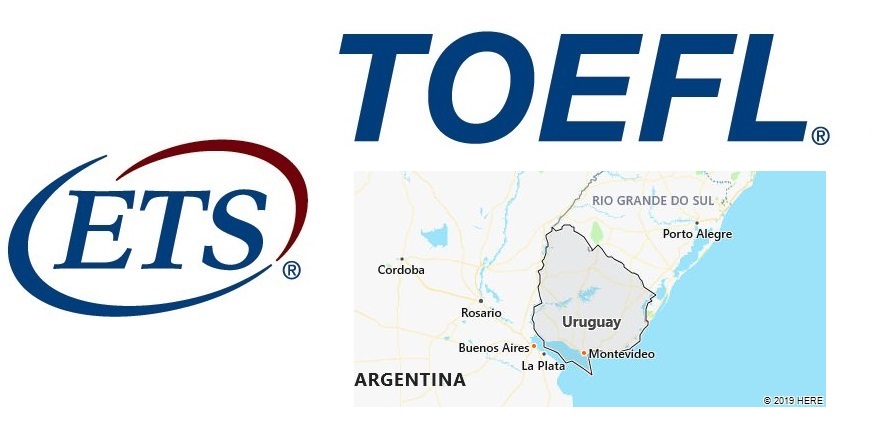The TOEFL iBT test is offered in this location.
The list below shows testing regions, fees and dates as of February 15, 2019, but availability may change when you register. Fees are shown in US$ and are subject to change without notice.
| Region | Testing Format | Fee | Test Dates |
|---|---|---|---|
| Montevideo | TOEFL iBT | $195 $195 $195 $195 $195 $195 $195 $195 $195 $195 $195 $195 |
Sat., Feb 16, 2019 Fri., Mar 08, 2019 Sat., Mar 09, 2019 Sat., Mar 16, 2019 Sat., Mar 30, 2019 Fri., Apr 05, 2019 Sat., Apr 13, 2019 Sat., May 04, 2019 Sat., May 11, 2019 Sat., May 18, 2019 Sat., Jun 01, 2019 Fri., Jul 12, 2019 |
Uruguay Overview
Uruguay [ ʊ rugva ɪ, uru gva ː i, Spanish uru ɣ a ], officially Spanish República Oriental del Uruguay, German Oriental Republic of Uruguay, State South America with (2018) 3.4 million residents; The capital is Montevideo.
Country facts
- Official name: Republic of East Uruguay
- License plate: ROU
- ISO-3166: UY, URY (858)
- Internet domain:.uy
- Currency: 1 Uruguayan peso (urug $) = 100 centésimos
- Area: 176,220 km²
- Population (2018): 3.4 million
- Capital: Montevideo
- Official language (s): Spanish
- Form of government: Presidential Republic
- Administrative structure: 19 departments
- Head of State: President Luis Lacalle Pou (since 1.3.2020)
- Religion (s) (2006): 47% Roman Catholic; 11% Protestant denominations; 40% no religious affiliation, atheists or agnostics; 1.5% minorities and other religions
- Time zone: Central European Time –4 hours
- National holiday: August 25th
Location and infrastructure
- Location (geographical): South America
- Location (coordinates): between 30 ° 05 ‘and 34 ° 58’ south latitude and 53 ° 07 ‘and 58 ° 28’ west longitude
- Climate: Subtropical-temperate climate
- Highest mountain: Cerro Catedral (514 m)
- Road network (2010): 77 732 (of which 7 743 km paved)
- Railway network (2016): 1,673 km
Population
- Annual population growth (2018): 0.27%
- Birth rate (2018): 13 per 1,000 residents.
- Death rate (2018): 9.4 per 1,000 residents.
- Average age (2018): 35.1 years
- Average life expectancy (2018): 77.6 years (men 74.4; women 80.8)
- Age structure (2018): 19.9% younger than 15 years, 14.4% older than 65 years
- Literacy rate (15 year olds and older) (2017): 98.6%
- Mobile phone contracts (pre-paid and post-paid) (2017): 147 per 100 residents
- Internet users (2017): 68 per 100 residents
Economy
- GDP per capita (2018): US $ 17,165
- Total GDP (2018): US $ 60 billion
- GNI per capita (2018): US $ 15,650
- Education expenditure (2011): 4.4% of GDP
- Military expenditure (2018): 1.95% of GDP
- Unemployment rate (15 years and older) (2017): 8.1%
Location
Uruguay borders in the southeast on the Atlantic Ocean, in the south on the Río de la Plata, in the west on the Río Uruguay (border with Argentina) and in the north on Brazil.
Uruguay occupies the extreme south of the Brazilian Shield, which emerges as a 200 km wide border in the south. In most of Uruguay, the Precambrian base of the Brazilian Shield is covered by Paleozoic and Mesozoic rocks. The layers, which dip slightly to the west and northwest, form distinctive strata. The most important is developed in the trapezoidal ceilings of the Triassic (reinforced in places by intermediate sandstones), in the Cuchilla de Haedo (up to 274 m above sea level) and Cuchilla Negra (300–400 m above sea level) in the north.
The Río Uruguay follows the western, tectonically conditioned demolition of the Brazilian Shield. The rivers flowing towards it divide Uruguay into east-west running hills, also called Cuchillas. Overall, this creates the character of a wide hilly country, which is dominated by layers and hardened rocks (in the crystalline). Only 10% of the land exceeds 200 m above sea level. The highest point in the country (514 m above sea level) is in the Sierra de las Ánimas, the southern continuation of the elongated Cuchilla Grande, the main watershed of the country. The eastern coastal strip, on the open Atlantic, consists of alluvial land with lagoons and spits (especially Laguna Merín). The coastal area of the Crystalline on the Río de la Platais covered with loess in a width of 100–120 km and has been the main arable farming area in the country since the middle of the 19th century.
Climate
Uruguay has a warm temperate, subtropical, fully humid climate, which is influenced by both the humid air masses from the northeast and cold air ingress from the south (Pamperos). The summer mean temperatures are between 21 and 23 ° C on the coast and 25 and 26 ° C in the north, in winter 10-14 ° C (in winter also frosts). The main rainy season is autumn, in the north-west summer; the annual rainfall reaches 900–1,000 mm in the south, in some cases more than 1,300 mm in the north. Droughts and heavy precipitation with floods occur at longer intervals.
Vegetation
The vast grassy areas of the Campos, which are now scarce or without trees and are used as natural pastures, are predominant; In the damp lowlands there are still remnants of the natural trees of the former park landscape, in dry locations there are xerophytes and cacti. Overall, the vegetation of the Campos is richer and more suitable for pasture use than that of the Argentine pampas.

